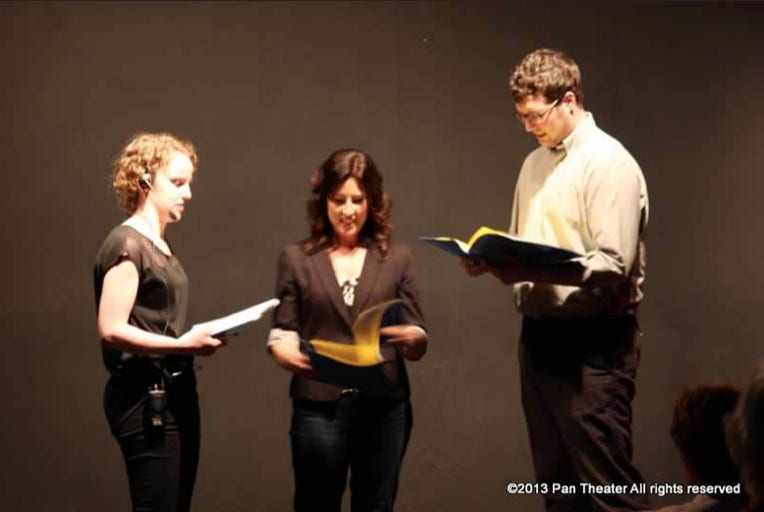Making Sense of the Merkle

Pan Theater Awkward Show - 2009
article by Doug Kassel (Copyright, 2004)
Improvisational training helps you become more creative and spontaneous.
Part of the process includes being able to let go of logical thinking, censorship, negative judgment, and other things to help you “get out of your own way.”
Thinking takes you out of the moment and gets in the way of spontaneity. Improv encourages you to be able to act and speak without conscious thought, when necessary
Our brains are conditioned to think logically. Our brains like order. We like to analyze, choose the right word, come to the point, be “clear thinkers,” and have our “heads on straight.” Sometimes it can be difficult to just open your mouth and surprise yourself.
For this, we have “merkle.”
Merkle is a term used to describe non-linear, non-associative speech, as in words thrown together at random. All the words you have ever used or heard are floating around in your head somewhere. The trick is to allow them to come out without putting them in any order. (I’ve been told that the term used by mental health professionals who treat patients who speak like this involuntarily, is Word Salad.)
I often see anxiety in students before attempting the exercise. Either they fear that nothing will come out, or that something will come out (as in embarrassing or revealing).
There are 3 tools I find helpful in developing the Merkle:
1. Non-association
2. Word Rhythm
3. Found Words
1. Non-association
The first step in merkling is for the student to stand and throw out non-associative words for a total of one minute. The only rule is that you cannot stop. It’s okay to repeat words, make up words, or even rhyme; anything that keeps you going. Your brain is probably going to want to fight you because it wants to be logical by making categories and lists. Often, early attempts at merkling are rather narrow: “red… blue… yellow…” or “chair… desk… lamp…” It takes some time to be non-associative:
“Rhubarb, Excalibur, sycophant, dipstick, lemur, pontoon…etc.”
It is possible to use associations to get to non-associative words. As the words come out, images may arise. The next word may come out of one of those images. For instance, you may have said, “Plaid.”
That word may conjure up the image of the cute girl in grade school who wore a plaid skirt and offered you licorice. Hence, your next word may very well be “licorice.” There is no obvious, logical association between those two words, only a personal one. The listeners will never know how you got there.
Non-association (or at least non-obvious association) is one tool to use in the merkle.
2. Word Rhythm
Another way to approach the merkle is by ignoring the meaning and just playing with the rhythm of the words; sort of a verbal drum solo. Each word has its own arc or sine wave. Some are soft, long and flowing while others are short, sharp and staccato: Lothario, evocative, vichyssoise, tick, nomenclature, cracker, stump.
If you really elongate the vowels and/or clip the consonants, you will hear the music of each word. Another thing to be aware of is the number of consonants in each word. Again, our brain wants to find patterns, so if you start with a two consonant word or phrase, the brain wants to find more and you sometimes can get into a sing song:
Hong Kong, bullfrog, armpit, etc.
Constantly changing numbers of syllables will automatically add variety to your merkle.
3. Found Words
I call these “found” words because you start a word without knowing what it is until you finish it. Just start with a word sound (vowel, consonant, diphthong) and let the rest of the word finish itself. Th-ermometer, Gr-acious, Ph-ilatelist, E-vangelical. Once you commit to starting a word, it’s pretty easy to finish it.
You can practice these steps separately, until they become second nature. I find that if sometimes I am feeling blocked during a merkle, I will jump to one or another of these techniques to keep me going.
Everyone has his or her own personal style of merkling. It’s fun to see how different people’s minds work when they can’t hide. Some people use short connecting phrases to create sort of a parody of bad beat poetry:
Incandescent marmosets in cantilevered sobriety, castigating cheese balls with Mormon distain, clutching onto fishhooks au gratin and dreams of mismanaged portfolios…etc.
Fortunately, Merkling is something you can practice in the privacy of your own head. No one has to know. It’s, at least, entertaining and will help you keep your creative channels open.
Have fun!
Doug Kassel, November, 2004. Note this article may NOT be reprinted without express permission of the author. To request permission please email pantheater with the article name and author’s name.